
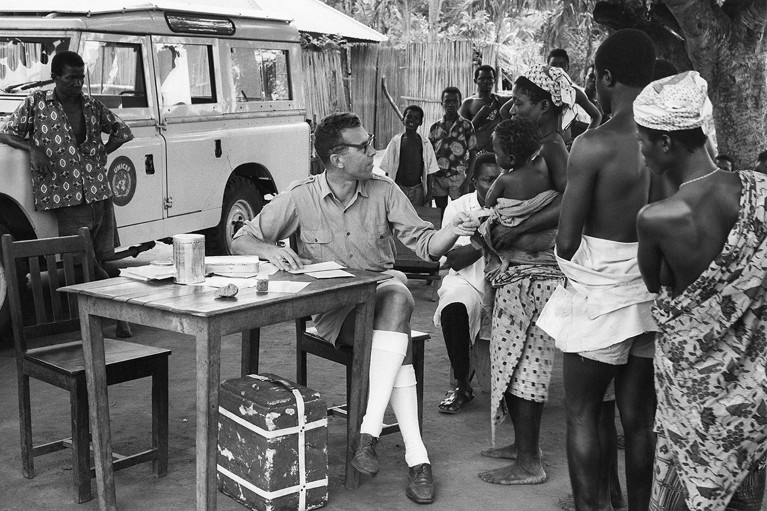
Within the late twentieth century, physicians in Togo collected knowledge to gauge the success of campaigns carried out towards the pores and skin illness yaws.Credit score: GRANGER Historic Image Archive/Alamy Inventory Photograph
In 1980, the World Well being Group (WHO) introduced the profitable eradication of smallpox — the primary and solely human infectious illness to be stamped out. However earlier than smallpox was on the WHO’s eradication docket, there was yaws.
Yaws is a pores and skin illness brought on by the corkscrew-shaped bacterium Treponema pallidum subsp. pertenue, an in depth relative of different Treponema micro organism, together with people who trigger syphilis. A yaws an infection begins with wart-like tumours on the pores and skin that flip into ulcers. Micro organism from the ulcers can unfold between individuals by way of direct pores and skin contact and, though lesions may heal with out remedy, the bacterium can then lie dormant within the physique for years. If it re-emerges, it will probably trigger painful irritation and destruction of bone and surrounding tissue, which may result in incapacity in 10% of instances1. In 2012, the WHO, inspired by analysis on a brand new remedy, dedicated to eradicating yaws by 2020. However, there are nonetheless 1000’s of instances being reported at present.
Yaws principally impacts youngsters in rural, low-income communities in tropical areas of Africa, Asia, Latin America and the Pacific (see ‘Yaws instances have gone extensively unreported’). “Such a continual, disfiguring and debilitating childhood infectious illness could be very disturbing for them of their studying,” says Lydia Sahamie, a neighborhood health-care employee in Papua New Guinea, the place nearly all of instances are being reported at present.
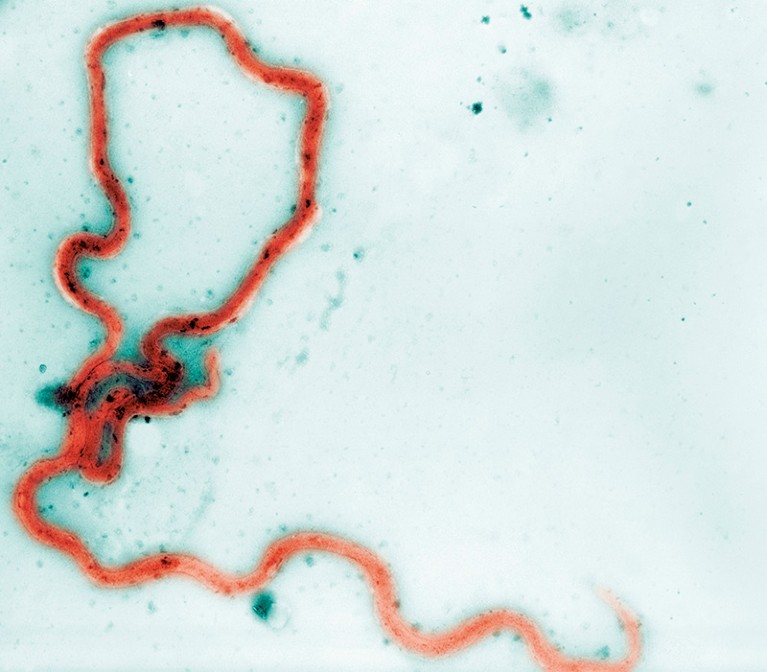
Treponema pallidum subsp. pertenue is a spiral-shaped bacterium that causes the pores and skin illness yaws.Credit score: Cultura Artistic RF/Alamy Inventory Photograph
Efforts to manage and eradicate yaws return a long time. “For the reason that WHO was established in 1948, yaws has been on the agenda,” says Kingsley Bampoe Asiedu, who grew up in Ghana — the place yaws is endemic — and is now a medical officer within the Division of Management of Uncared for Tropical Ailments on the WHO in Geneva, Switzerland. From the early Nineteen Eighties till now, focused intervention campaigns in endemic areas have targeted on preventative measures to scale back transmission — together with neighborhood schooling on the significance of non-public hygiene — in addition to bettering diagnoses and entry to remedy. Only one dose of a reasonable oral antibiotic referred to as azithromycin can clear the yaws-causing bacterium from the particular person’s system, permit their ulcers to heal and reverse irritation. “How large is the injustice that these youngsters would not have a 20 cent drugs?” says Oriol Mitjà, an infectious-disease doctor and researcher at Germans Trias i Pujol College Hospital in Barcelona, Spain.
Though campaigns have introduced some success, impediments which have existed for many years nonetheless stay — together with a scarcity of sources to succeed in and deal with individuals in distant areas and to watch the illness. New challenges have additionally emerged.
A part of Nature Outlook: Uncared for tropical illnesses
“The story has gotten much more sophisticated within the final 5 years,” says world public-health researcher Camila González-Beiras at Germans Trias i Pujol College Hospital, who additionally leads fieldwork on Lihir Island, Papua New Guinea. Instances of antibiotic resistance emerged in 2020, as has proof that our primate kinfolk harbour the identical yaws-causing bacterium — opening up the chance that yaws may reinfect individuals even when eradication in people is profitable. Moreover, there are numerous infections that may trigger ulcers which can be comparable in look to yaws, which makes diagnoses tougher, says González-Beiras.
Nonetheless, yaws stays one in every of simply two WHO uncared for tropical illness eradication targets for 2030. At first look which may sound just like the group is transferring the goalposts and may increase questions on why the 2030 goal is any extra lifelike than the now-passed 2020 one. However researchers and public-health employees are cautiously optimistic that this time, the objective is inside attain, because of advances in remedy choices and persevering with work to make extra correct diagnoses and surveillance potential.
From penicillin to vaccines
In 1952, the primary yaws eradication marketing campaign was launched, and injections of penicillin-based antibiotics got out internationally. “They handled 50 million individuals for yaws and decreased the worldwide burden of illness by 95%,” says Michael Marks, an infectious-disease doctor and researcher on the London Faculty of Hygiene & Tropical Medication. “If that preliminary marketing campaign didn’t have the ‘E’ phrase connected to it, it might have been counted as a shocking public-health success.”
The final mile of the eradication journey is usually probably the most tough, Marks says, as a result of “as one thing turns into much less of a burden, it turns into tougher to prioritize it”. With waning sources and a scarcity of surveillance, there was a resurgence of yaws within the Nineteen Seventies.
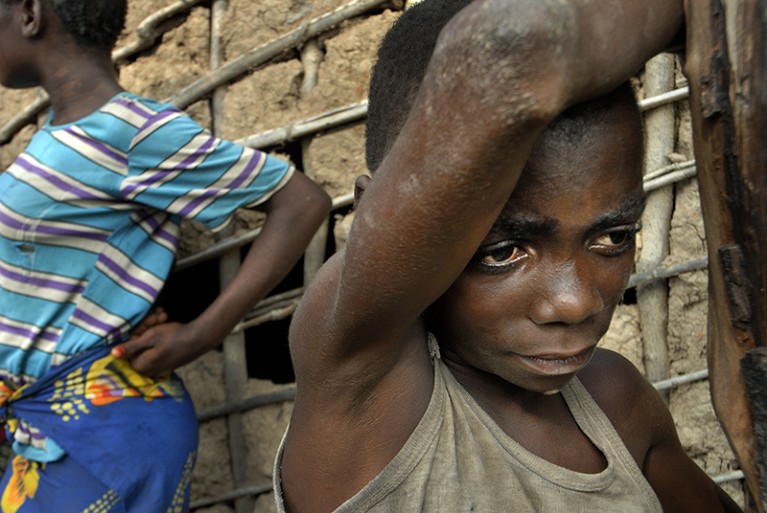
The bacterial an infection yaws begins with wart-like tumours on the pores and skin.Credit score: Graeme Williams/Panos Footage
The subsequent large push to do away with yaws got here in 2012, following the work of Mitjà and his colleagues, who confirmed {that a} single dose of azithromycin could possibly be used rather than penicillin2. In contrast with penicillin, azithromycin is less complicated to acquire, transport and administer — it’s given as a pill, or often a syrup, so it does away with the discomfort of an injection and doesn’t require administration by health-care employees.
However as 2020 got here to an in depth, there have been nonetheless greater than 300 confirmed instances and greater than 80,000 clinically suspected instances of yaws worldwide. Much more ominously, in October of that 12 months, Mitjà, González-Beiras, Marks and their colleagues revealed knowledge on the primary instances of azithromycin-resistant yaws — a improvement that threatened to neutralize what had grow to be probably the most highly effective weapon towards the illness3.
Thankfully, penicillin continues to be an efficient fall again choice in instances of azithromycin resistance. And additional choices are on the way in which. Particularly, a drug referred to as linezolid is being evaluated in a medical trial in Papua New Guinea. Much like azithromycin, linezolid is a pill that’s simple to move and administer. “Up to now it appears actually promising,” says Gonzáles-Beiras, who’s main the trial. Final 12 months, Mitjà, Marks, González-Beiras and their colleagues additionally reported the outcomes of an up to date remedy method that would scale back instances additional. They discovered that administering three rounds of mass remedy of azithromycin to everybody in a neighborhood at six-month intervals, in contrast with a traditional single spherical adopted by focused remedy, led to a major discount in yaws instances4.
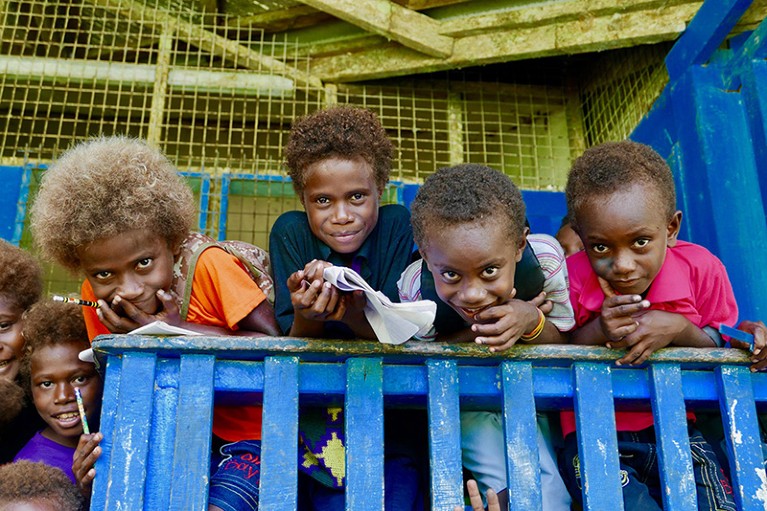
Kids wait their flip to take part in a yaws screening and remedy intervention as a part of a medical trial on Lihir Island, Papua New Guinea.Credit score: Dr Camila González Beiras
Even higher could be a yaws vaccine, which would scale back the necessity for antibiotics altogether. Though there isn’t a vaccine particularly for yaws in improvement, some researchers are engaged on a syphilis vaccine. The Treponema micro organism that trigger yaws and syphilis are almost equivalent, so a syphilis vaccine may supply cross-protection for yaws.
Making a vaccine for both an infection is a problem, as a result of a protein on the microbe’s outer coat that might be focused by a vaccine, referred to as the TprK antigen, is continually altering5. “There are actually thousands and thousands of permutations of how this protein can look. So the immune response merely can’t sustain with it,” says Sheila Lukehart, a retired global-health researcher on the College of Washington in Seattle.
Instruments for monitoring
Within the absence of a vaccine, the following finest weapon to wipe out yaws is to precisely diagnose and deal with individuals after which proceed to fastidiously monitor instances. “To do a medical prognosis simply by the look of the ulcer is extremely tough,” says González-Beiras. And if ulcers are mistaken as yaws however don’t reply to azithromycin remedy, she provides, it may negatively have an effect on the social notion of those interventions and “jeopardize the progress of eradication”.
Blood checks can be found that may decide whether or not an individual is contaminated with a Treponema bacterium (or has been beforehand) however, even then, not all Treponema reply to azithromycin. A number of strains of Treponema that trigger syphilis are azithromycin resistant. Figuring out exactly which bacterium is inflicting the ulcer requires molecular testing. Sadly, these checks fare poorly within the warmth of the tropics as a result of many reagents should be stored refrigerated, so samples have to be despatched off for sequencing, and outcomes don’t come again till lengthy after an individual is handled, presumably ineffectively. Researchers are designing hardier take a look at options that might permit for the samples to be analysed nearer to a remedy web site, reminiscent of loop-mediated isothermal amplification (LAMP), which makes use of reagents and tools which can be much less delicate to warmth6. However, up to now, none of those approaches have been proven to be notably dependable, says González-Beiras.
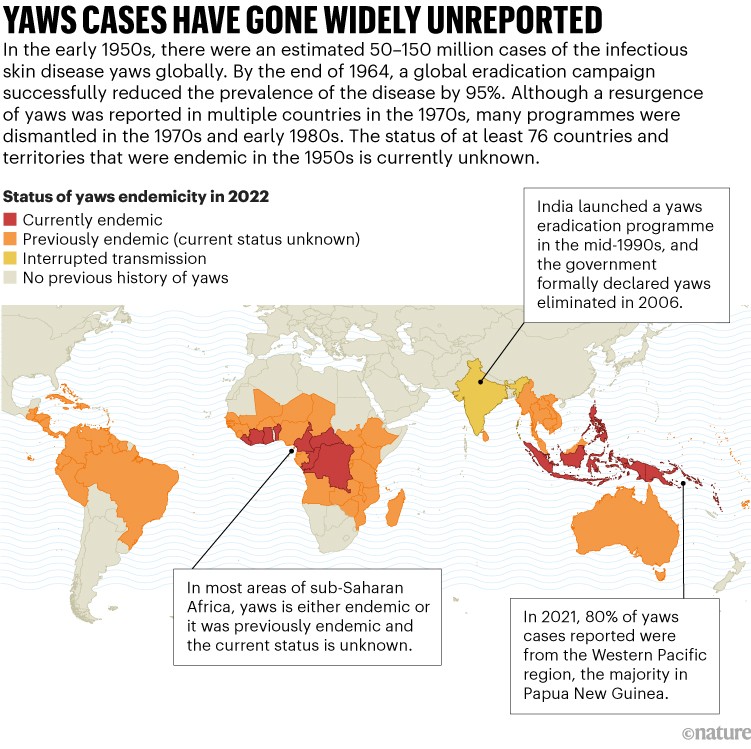
Supply: WHO
For illness surveillance to succeed, instances of yaws will should be recognized rapidly and precisely — and that’s not occurring. As we speak there are 15 international locations with reported instances of yaws, however that’s most likely an undercount. Many years in the past, many international locations stopped reporting instances to the WHO. There are at the very least 76 beforehand endemic international locations the place the standing of the illness is unknown, which Marks says raises the query of whether or not “absence of proof is identical as proof of absence”?
Monitoring human instances of yaws is difficult sufficient, however the affirmation that the pathogen additionally infects a few of our closest animal kinfolk poses one other surveillance hurdle.
The primate reservoir
For almost a century, it was thought that people had been the unique host of the bacterium that causes yaws. However in 2018, Sascha Knauf, director of the Institute of Worldwide Animal Well being/One Well being in Greifswald, Germany and his colleagues discovered that non-human primates harbour the identical bacterium7.
There’s at the moment no proof that T. pallidum subsp. pertenue has ever spilled over from non-human primates to people. However that’s removed from a assure towards such transmission sooner or later. Different uncared for tropical illnesses that had been additionally as soon as considered current solely in people had been later discovered to contaminate different animals as properly. “Should you went again to 1990, individuals didn’t assume that canine had been essential within the transmission of Guinea worm,” says Marks. However now it’s identified that canine are in reality an essential reservoir for the parasite that causes this extreme, painful an infection.
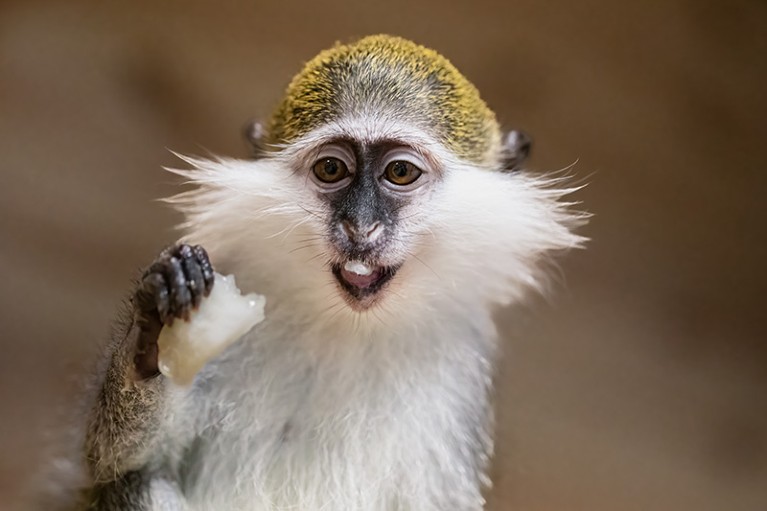
In 2018 it was reported that non-human primates, together with inexperienced monkeys (Chlorocebus sabaeus), harbour the bacterium that causes yaws.Credit score: Olena Shvets/Getty
“Within the areas the place people co-exist with contaminated non-human primates, we’ve got to proceed surveillance,” says Knauf, even when we had been to eradicate yaws in people. “If it spills over — and if there isn’t a surveillance — it’s going to imply you miss it after which in 10 or 20 years you’ll probably see human instances once more.”
Efficient remedies, diagnostics and surveillance are simply a part of the eradication equation. “You could have the instruments,” says Asiedu, “however getting the instruments to these in want is a problem.”
Reaching distant communities
Those that need assistance are actually receptive to it, says Nana Konama Kotey, who heads Ghana’s yaws eradication programme in Accra — even in locations the place each the final inhabitants and health-care employees lack consciousness and data of yaws. That makes her much more optimistic about elimination in Ghana particularly. “Assuming we’ve got 100 communities, possibly one will refuse,” she says, “after which we attempt to appropriate no matter misconceptions they’ve.”
The primary hurdle, Kotey says, is to safe the funding wanted to diagnose and deal with goal populations. “The most important value in a variety of campaigns is reaching individuals,” echoes Marks. In an unlucky paradox, success in anti-yaws campaigns can undermine assist. Funders and public-health organizations which can be desirous to assist efforts in distant areas the place there are tons of or 1000’s of instances are likely to lose curiosity when the case numbers dwindle to a handful.
Essential for goal-setting within the yaws eradication effort, says González-Beiras, is a greater understanding of what’s potential to attain in communities. Most of the pointers and protocols issued by well-meaning organizations, she says, come throughout as oblivious to the realities on the bottom. These paperwork embody language about hospitals and health-care centres — however such institutions, and even remedy services with electrical energy, could be uncommon in locations reminiscent of Papua New Guinea.
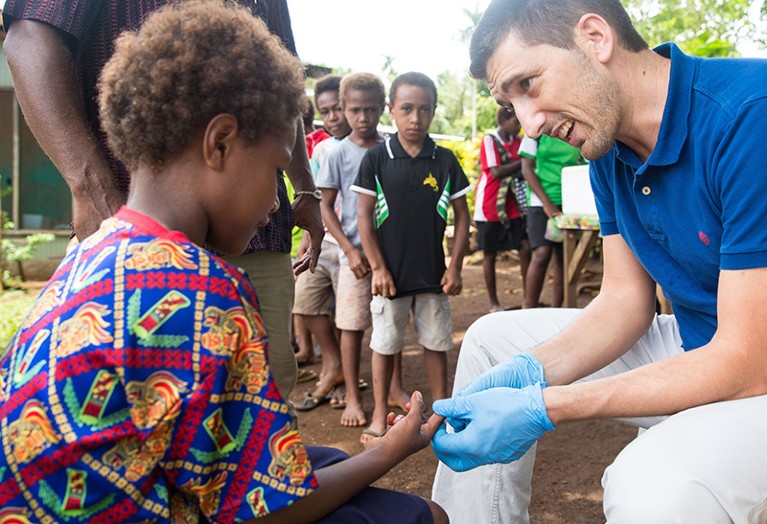
Infectious-disease doctor Oriol Mitjà treats youngsters with yaws in Papua New Guinea.Credit score: Graham Jepson
Along with setting objectives according to the sources obtainable, sustaining surveillance to make sure eradication means constructing a neighborhood workforce to proceed with these efforts in locations the place yaws is endemic, says González-Beiras. “You are able to do all of those helicopter interventions the place you come and provides antibiotics to everybody — however what’s going to occur in six months, two years, 5 years, ten years?”
That’s the place individuals like Sahamie and Kotey play such essential components. In Ghana, Kotey will not be solely concerned in growing complete plans and methods for the elimination of yaws, however can also be facilitating collaboration amongst authorities departments, health-care suppliers, neighborhood leaders and non-profit organizations. In Papua New Guinea, alongside González-Beiras, Sahamie — at the moment a scholar at Divine World College’s St Mary’s Faculty of Nursing in Vunapope, Papua New Guinea — helps with the linezolid drug trial.
“Whenever you land in Papua New Guinea, there may be this large banner that claims, ‘The land of the surprising’, and it couldn’t be extra true,” says González-Beiras. “Something can occur. There are such a lot of variables. There are such a lot of cultural variations.” It takes years to develop a community and achieve belief, she says, “however when you’re in, you’re in”. As we speak, González-Beiras has hope for Papua New Guinea due to native individuals reminiscent of Sahamie, who started yaws elimination work with little earlier coaching. “They’re managing the entire mission proper now themselves,” says González-Beiras, from her laboratory in Spain. “They’re doing a tremendous job.”
